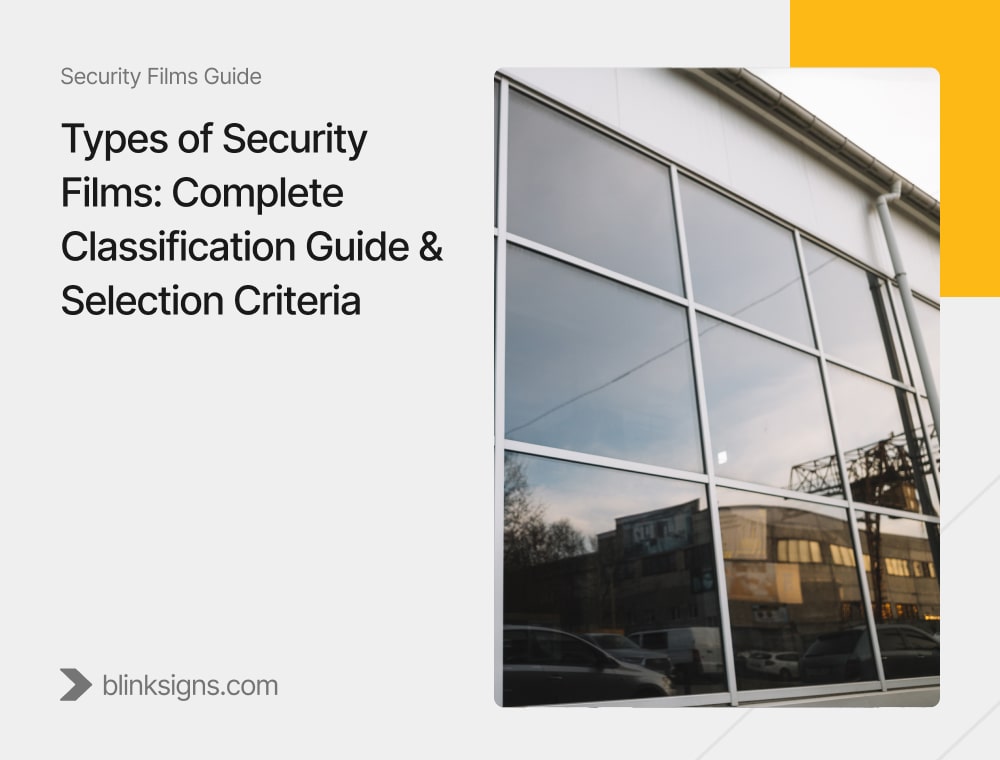
Types of Security Films: Complete Classification Guide & Selection Criteria
Why Security Film Classification Matters
A storefront window is often the first barrier between a business and a threat. A burglary attempt, a storm, or even a minor accident can quickly break glass that appears strong. Long after the glass replacement, the business bears the costs of repairs, lost inventory, and damaged reputation. Many business owners realize too late that a simple security film could have prevented it.
Security films are not all the same. Some are designed to keep glass from shattering during an impact, while others protect against smash-and-grab thefts, violent storms, or even blast events. Others combine safety with solar control, glare reduction, or privacy. Choosing the wrong type creates a false sense of safety and exposes vulnerabilities.
By understanding the complete classification of types of security films and the technical specifications behind each type, businesses and homeowners can select the right film the first time. At BlinkSigns, security film solutions are tailored to threat level, compliance requirements, and budget, so properties are protected without compromise.
What Are Security Films? (Definition & Core Functions)
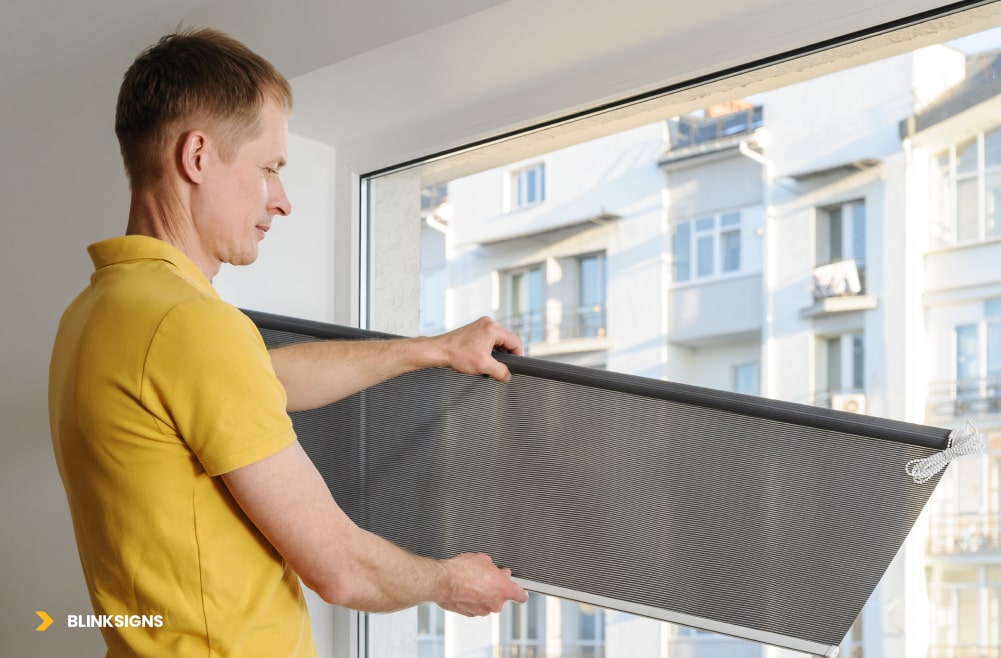
What Are Security Films
Security films are clear or tinted polyester layers bonded to existing glass. When applied correctly, they reinforce glass against impact and hold shattered fragments together, preventing dangerous breakage.
How Security Films Work
Multiple layers of strong polyester are fused with powerful adhesives. When a window strikes, the glass may crack, but the film holds the fragments in place. The result reduces the chance of forced entry, flying debris, or injury.
Benefits Beyond Security
While the primary purpose is protection, secondary benefits are also provided:
- UV rejection that reduces interior fading.
- Glare reduction for better comfort in workspaces.
- Energy efficiency by reducing heat transfer.
- Privacy through tinted or frosted finishes.
This combination makes security films a multi-purpose upgrade rather than a single-function expense.
Core Classification of Security Films
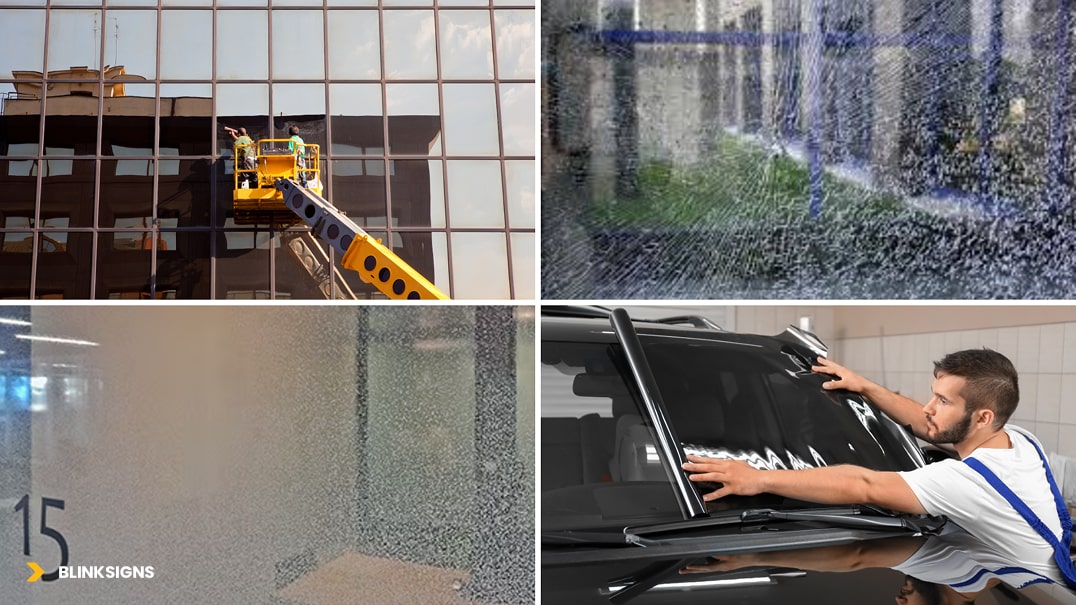
Core Classification of Security Films
Security films are classified according to their primary function and use case. Each category is built for specific risks and environments.
Anti-Shatter & Safety Films
Designed to keep glass from scattering into sharp fragments. Often used in schools, homes, and small offices where basic safety compliance is required.
Blast Mitigation & Impact Films
Engineered to absorb shock waves and high-energy impacts. Recommended for government facilities, transportation hubs, and high-risk commercial sites.
Solar Security Films
Combine safety with UV rejection, glare reduction, and energy savings. Corporate offices and retail spaces often use these to seek comfort and protection.
Privacy & Decorative Security Films
Offer branding or privacy while providing glass reinforcement. Healthcare, hospitality, and modern office interiors use these films.
Clear vs Tinted Security Films
Transparent films preserve natural light and visibility, while tinted films add privacy and heat control. Selection depends on whether visibility or aesthetics are prioritized.
Technical Specifications by Film Type
Specifications determine the true strength of a security film. We must match the thickness, adhesive systems, and optical clarity to the threat level.
Film Thickness Comparison
- 4 mil films: provide basic safety; suitable for residential and low-risk environments.
- 6–8 mil films: standard for retail storefronts and commercial offices to resist forced entry.
- 12 mil films: heavy-duty films for blast protection, severe storm areas, or government facilities.
Adhesive Systems & Anchoring Methods
- Pressure-sensitive adhesives: quick bond, common in commercial applications.
- Dry adhesives: smoother optical clarity, but require expert installation.
- Edge anchoring systems: Reinforce the bond between film and frame for high-threat environments.
Optical & Light Transmission Factors
- Visible Light Transmission (VLT): affects brightness inside a space.
- Infrared rejection: reduces heat load from sunlight.
- Optical clarity rating: ensures visibility is not distorted.
Security Film Classification & Specification Comparison
| Film Type / Thickness | Core Use Cases | Benefits | Durability (★) | Cost ($) | Adhesive & Anchoring Options | Optical / Light Features |
|---|---|---|---|---|---|---|
| Anti-Shatter & Safety (4 mil) | Homes, schools, small offices (basic safety) | Prevents glass scatter, meets minimum safety compliance | ★★☆☆☆ | Low | Pressure-sensitive adhesive (basic) | Clear; standard light transmission |
| Blast Mitigation & Impact (12 mil) | Gov’t buildings, airports, high-risk sites | Withstands blasts, storms, forced entry attempts | ★★★★★ | High | Dry adhesive + Edge anchoring for max hold | High clarity; some light reduction |
| Solar Security (6–8 mil, tinted/clear) | Corporate offices, retail storefronts | Combines UV protection, glare reduction, burglary defense | ★★★★☆ | Medium | Pressure-sensitive / dry adhesive | Visible Light Transmission (VLT) 35–70%, IR rejection for heat |
| Privacy & Decorative (6–8 mil) | Healthcare, hospitality, office interiors | Adds privacy/branding + reinforcement | ★★★☆☆ | Medium | Pressure-sensitive adhesive | Available in frosted/tinted; moderate VLT |
| Clear Films (varies 4–12 mil) | Where visibility is critical | Safety + security without changing aesthetics | ★★★–★★★★★ | Low–High | All adhesive types depending on thickness | High optical clarity |
| Tinted Films (6–8 mil typical) | Offices & retail needing privacy + heat control | Adds aesthetic, reduces glare, offers added security | ★★★★☆ | Medium | Pressure-sensitive / dry adhesive | Reduces brightness, lowers solar heat |
“The wrong film selection leaves windows looking protected while offering little resistance when it matters most. A 4 mil safety film may stop glass scatter, but it will not hold up against a smash-and-grab attempt. A clear solar film may reduce glare, but without proper thickness, burglary resistance is not delivered.”
At BlinkSigns, security films are not recommended by guesswork. They are matched to facility type, risk level, and compliance requirements so business owners know their investment will perform under pressure.
Protection & Application Areas
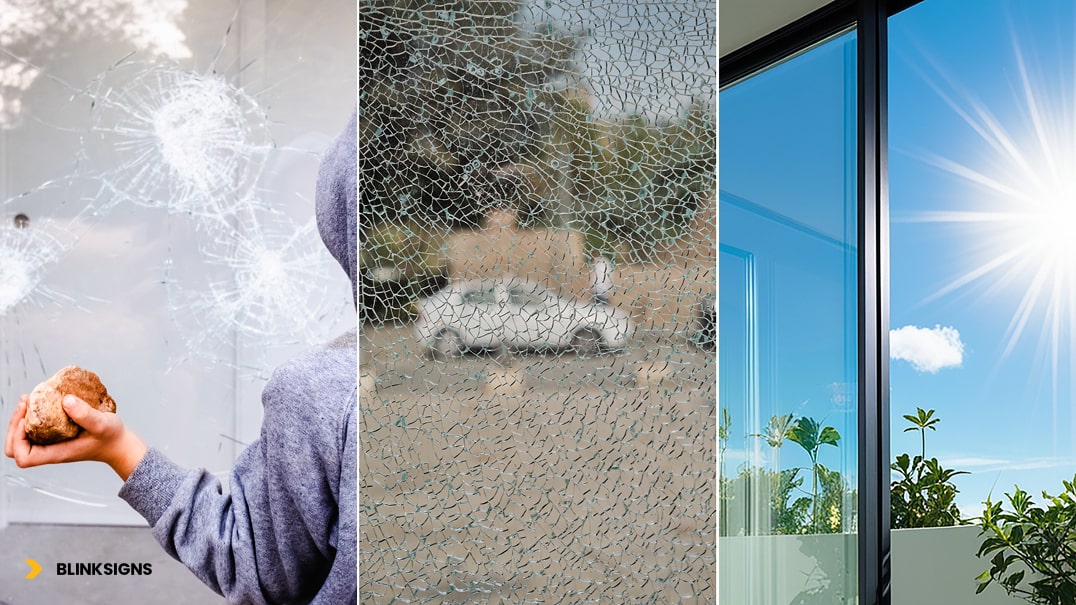
Protection & Application Areas
Security films are only effective when chosen for the right environment. Each application has different risks, and film selection must be matched accordingly.
Burglary & Forced Entry Resistance
Retail storefronts and small businesses are frequent targets for smash-and-grab thefts. Security films in the 6–8 mil range slow intruders and keep glass intact long enough to deter entry.
Natural Disaster Protection
In storm or earthquake-prone areas, films prevent glass from scattering. Twelve mil films and anchoring systems protect against flying debris and severe winds.
Institutional Use Cases
- Schools: safety films protect against accidents and security threats.
- Healthcare facilities: films reinforce glass in patient areas while reducing UV exposure.
- Government & airports: Blast-resistant films reduce risks from intentional or accidental explosions.
Residential vs Commercial Films
Homes often use films for UV, privacy, and basic safety, while commercial properties demand impact resistance, compliance, and insurance-approved solutions.
Standards & Compliance for Security Films
Regulatory standards ensure that films meet safety and durability benchmarks. Businesses that skip compliance face failed inspections and denied insurance claims.
U.S. Federal Standards
- ANSI Z97.1: safety glazing for human impact.
- CPSC 16 CFR 1201: consumer safety standard for glazing.
- ASTM impact resistance tests for shatter performance.
Building Code Compliance
- ICC codes apply to commercial and institutional facilities.
- Local building inspectors enforce adherence during installations.
Energy & Sustainability Credits
Solar security films may contribute toward LEED credits by improving energy efficiency while doubling as protective layers.
Insurance Incentives
Installing certified security films in high-risk facilities often results in premium discounts from many insurers.
Selection Criteria — Choosing the Right Film
Selecting the correct film involves balancing cost, security, and performance.
Thickness vs Threat Level
- 4 mil: basic safety, residential.
- 6–8 mil: burglary resistance, commercial use.
- 12 mil+: high-security, storms, and blast threats.
Cost & ROI Factors
Security films are priced per square foot. While initial costs vary, long-term savings from theft prevention, energy efficiency, and insurance discounts outweigh the upfront investment.
Energy & Comfort Benefits
Films block up to 99% of UV rays and reduce glare, protecting interiors and lowering energy bills.
Privacy vs Transparency
Transparent films maximize visibility, while tinted or frosted films add privacy and branding options.
Warranty & Lifespan
Professional-grade films last 10–15 years when installed and maintained correctly. Manufacturer warranties ensure consistent performance.
Installation & Maintenance Considerations
The performance of security films depends as much on installation as on thickness.
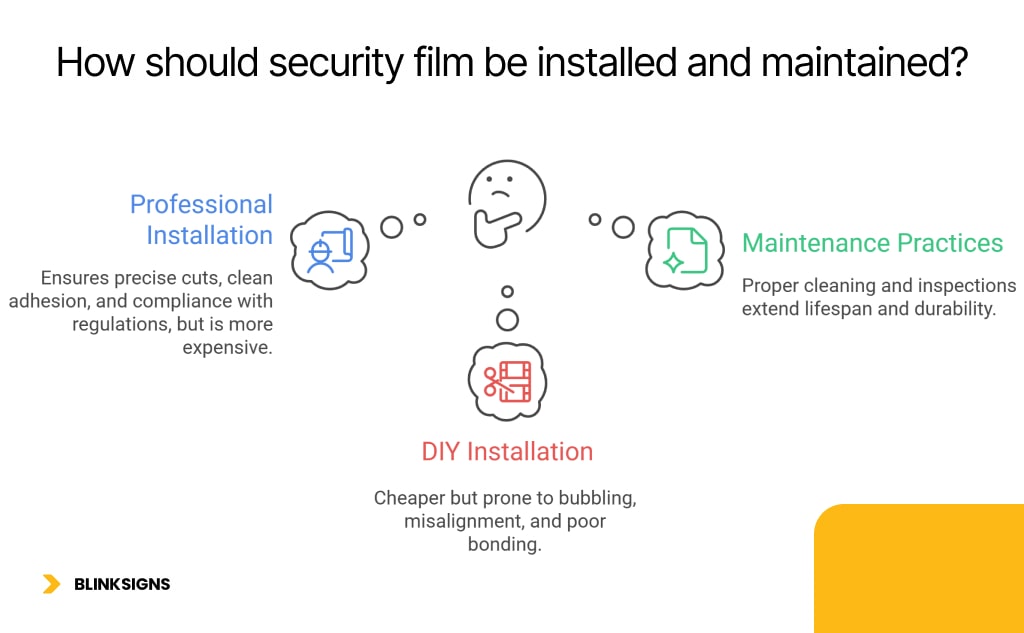
Installation & Maintenance Considerations
Professional vs DIY Installation
- Professional installation: ensures precise cuts, clean adhesion, and compliance with regulations.
- DIY kits: cheaper but prone to bubbling, misalignment, and poor bonding.
Step-by-Step Installation Process
- Surface preparation – windows cleaned and degreased.
- Film application – adhesive-activated, film aligned to glass.
- Edge sealing/anchoring – for high-threat applications.
- Curing – full adhesion achieved over several days.
Maintenance & Cleaning Rules
- Use non-abrasive cleaners only.
- Avoid sharp tools or rough cloths.
- Schedule periodic inspections for edge wear or peeling.
Lifespan & Durability
Typical lifespan is 10–15 years, depending on exposure, cleaning, and installation quality.
Industry-Specific Applications
Retail Storefronts
Protection from smash-and-grab thefts while maintaining product visibility.
Schools & Educational Institutions
Provides accident protection and reduces risks during security incidents.
Healthcare Facilities
Enhances patient safety and supports privacy while reducing harmful UV rays.
Government & Transportation Infrastructure
Blast-resistant films for airports, government offices, and transit hubs.
Hospitality & Corporate Offices
Combine aesthetic finishes with safety to maintain brand image and compliance.
FAQs About Security Films
What thickness of security film is best for burglary prevention?
For burglary resistance, 6–8 mil films are most effective. They delay forced entry and keep the glass intact longer.
How long does security film last on windows?
Most security films last 10–15 years when installed professionally and maintained correctly.
Can security films stop bullets or explosions?
Security films are not bulletproof. However, 12 mil blast mitigation films reduce risks by holding shattered glass together during explosions.
Is DIY security film compelling for home use?
DIY kits may provide minimal protection but often fail under real impact. Professional installation ensures proper bonding and compliance.
What is the difference between solar security film and transparent film?
Solar security films provide UV rejection, glare control, and energy savings, while transparent films maintain visibility and natural light.
How much does professional security film installation cost?
Costs vary by thickness and coverage, averaging $7–$15 per square foot for professional-grade films.
BlinkSigns Expertise in Security Film Solutions
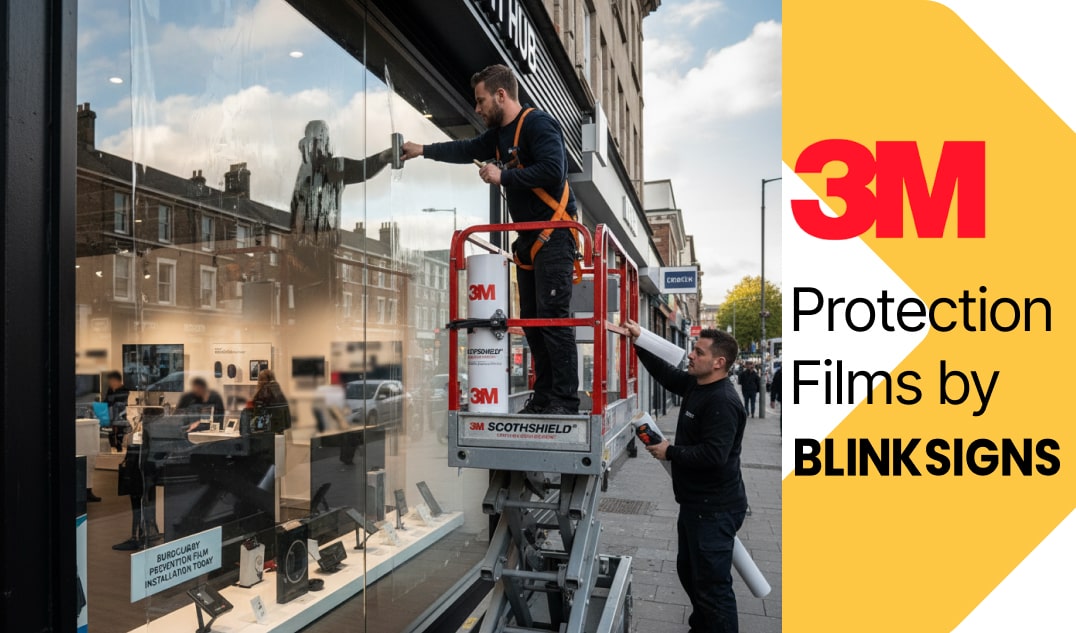
BlinkSigns Expertise in Security Film Solutions
At BlinkSigns, every project begins with a risk assessment. Our experts recommend films based on threat level, compliance requirements, and budget. We precisely deliver installations and verify them for long-term performance, from retail storefronts to government buildings.
Our services include:
- Consultation and selection guidance.
- Professional installation with compliance assurance.
- Multi-location rollout planning.
- Maintenance and warranty support.
👉 Contact BlinkSigns today to schedule a consultation and secure your property with the right protective film solution.
Conclusion
Windows are the most vulnerable entry points in any building. Glass offers little resistance to theft, storms, or accidents without security films. The correct classification and technical specifications determine whether a movie performs when needed.
BlinkSigns ensures every client receives the right product, is expertly installed, and is fully compliant.
📞 Take action today — protect your business and create safer spaces with BlinkSigns’ security film solutions.